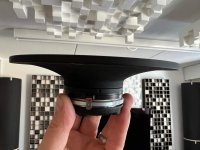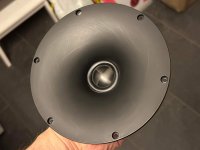First you have to decide if you build with a WG or not.At this price, a Be pair sb25 from Bielsma non horned is more tempting, even if crazy money for my average wallet ! (or at least fluid 34A horned if better for the ears !). I am even not sure a Bielsma Be 25 mm is better than a SB26ADC horned in an average european living room, uh !
But the Bliesma T25B is one of the best tweeter available! In fact my favourite choice from 25mm tweeters. I don't know the SB26ADC but if you don't want to think abut your tweeter choice again - you could just get the Bliesma and be done with it. ;-)
3D printing is getting more and more common - maybe you find a school where you could ask for a print. We have some "creative labs" here around where you can print for free, but that's probably not too common.
I've read augerpro's post about T25a and it doesn't work with the t25b waveguide.
Does anyone have knowledge if the silk dome t25s can work with the augerpro t25b waveguide?
Does anyone have knowledge if the silk dome t25s can work with the augerpro t25b waveguide?
As nicely as the be dome it won't, but the T25a had some artifacts, it was impossible to use with.No, it doesn't as nicely cause the membrane is not as flat as the B model.
@augerpro im currently using the sb26 in the 6.5 - will the t25b 6.5 WG slip into the same baffle cutout?
If it is the one labeled as having a 1 : 0.68 aspect ratio, it will not. If it is the one without "68" in the label, it will fit in the SB26 cutout.
If it is the one labeled as having a 1 : 0.68 aspect ratio, it will not. If it is the one without "68" in the label, it will fit in the SB26 cutout.
In general, is it the case that all the 6" 1:0.68 have the same footprints and thus will fit into the same cutout?
Sorry for the late bump, but has there been any simulation with the inner edge of the waveguide covering up the surround entirely, so that only the dome itself is firing into the waveguide? Now, obviously, this introduces another problem of diffraction off the inner edge because clearance is needed above the surround for excursion and manufacturing tolerance, but I feel that this could be adequately mitigated by stuffing felt into the annular gap created between the tweeter faceplate (around the surround periphery) and the inside of the inner edge of waveguide.Elliptical Waveguide TypeG
Here are simulations of design G with the new SB26ADC geometry (see post #80), with the step of design G and without the step, i.e. the SB26ADC membrane directly fitted to the WG contour.
Waveguide Type G looks like this:
View attachment 679839
The respective image within ABEC, WG TypeG with SB26ADC:
View attachment 679840
Horizontal radiation normalized to 0° (with step as shown above):
View attachment 679841
And the respective SPLs from 0° to 60°(with step as shown above):
View attachment 679842
Just as a 'control', the simulations without step, i.e. with the SB26ADC directly fitting to the WG contour:
View attachment 679843
and
View attachment 679844
Pretty much the same effect of the step as seen before.
Next steps probably...
...and variations of the WG contour.
Yes, I've done that at that time, i.e. evaluated different ways to fit the waveguide to the tweeter. Basically this works IIRC.Sorry for the late bump, but has there been any simulation with the inner edge of the waveguide covering up the surround entirely, so that only the dome itself is firing into the waveguide?
However, did that back in 2018 - I check if I have these simulations and will post them if still available.
I've been measuring a new batch of tweeters, and wanted to give an update and ask for some help from ABEC users. Two of the tweeters, Satori TW29TX and Scanspeak 6640, have wide surrounds and I've just not had much luck with those so far. But, early results are promising. The TW29TX looks pretty good out of the gate, and I think a revision or two and we'll have some good designs. The 6640 is ok-ish, but the tweaks I'm trying are showing the direction I should go in future revisions and I'm very hopeful we'll have good designs for it too. But the thing I'm most happy about is that the single waveguide I modeled for the 6640 in ABEC matched the actual measurements very close. That means the source dimensions I came up with are good. So here is where I need help, I'm going to post the source dimensions here for use in ATH/ABEC, all I ask in return is that if you use it, please direct your first efforts to waveguide with a 6" (152.4 mm) mouth, and a depth of 1" (25.4 mm). Hopefully we can generate some good ideas quickly and I don't have to waste time printing a bunch of iterations with tiny differences.
I've also attached two of my ATH config files. The "6x1_rA" file is the one that matches measurements well. It uses my usual flare consisting of a constant radius curve. "6x1_rA_OS4" is one I'm modeling right now using OS-SE flare.
Source.Contours = {
zoff -0.8
point p1 4.76 0 2.5
point p2 0 13.462 0.5
point p3 1.57 16.256 0.5
point p4 0 19.05 1.0
point p5 0 19.55 1
cpoint c1 -16.6522 0
cpoint c2 -1.6939 16.256
arc p1 c1 p2 1.00
arc p2 c2 p3 0.75
arc p3 c2 p4 0.25
line p4 p5 0
line p5 WG0 0
}
I've also attached two of my ATH config files. The "6x1_rA" file is the one that matches measurements well. It uses my usual flare consisting of a constant radius curve. "6x1_rA_OS4" is one I'm modeling right now using OS-SE flare.
Source.Contours = {
zoff -0.8
point p1 4.76 0 2.5
point p2 0 13.462 0.5
point p3 1.57 16.256 0.5
point p4 0 19.05 1.0
point p5 0 19.55 1
cpoint c1 -16.6522 0
cpoint c2 -1.6939 16.256
arc p1 c1 p2 1.00
arc p2 c2 p3 0.75
arc p3 c2 p4 0.25
line p4 p5 0
line p5 WG0 0
}
Attachments
Hi guys and Brandon. Just read through all of this in the last couple days. A lot to take in for a 'novice'! I will certainly be donating and getting some guides printed.
I'm struggling to visualize what we might need to implement regarding a passive XO. I know everyone's are different but even just the 'topology'?
I'll be using either SB26 or RST28 as I have both here. Haven't decided whether to pair on to my RS225. I built the XRK Ref Monitors. I swapped out the 3" FR as I think I needed the dispersion of a tweeter. I put in some Morel CAT378s , first order with 4.7uf and to my ears they sound much better. I know X had a theoretical build using the RS225 and the RS28 in the WG300.
So maybe I need an 8" guide for that particular speaker.
And I also have another build in the pipeline where I'll cross to a 5" mid in a 3 way.
I guess if doing a passive XO, we aren't for instance 1st order up high to slowly flatten the peak the guide gives us?! Or do we need a notch filter over that peak/plateau?
Any XO designs anyone could post just so I can get an idea of what folks are doing.?
Thanks!
I'm struggling to visualize what we might need to implement regarding a passive XO. I know everyone's are different but even just the 'topology'?
I'll be using either SB26 or RST28 as I have both here. Haven't decided whether to pair on to my RS225. I built the XRK Ref Monitors. I swapped out the 3" FR as I think I needed the dispersion of a tweeter. I put in some Morel CAT378s , first order with 4.7uf and to my ears they sound much better. I know X had a theoretical build using the RS225 and the RS28 in the WG300.
So maybe I need an 8" guide for that particular speaker.
And I also have another build in the pipeline where I'll cross to a 5" mid in a 3 way.
I guess if doing a passive XO, we aren't for instance 1st order up high to slowly flatten the peak the guide gives us?! Or do we need a notch filter over that peak/plateau?
Any XO designs anyone could post just so I can get an idea of what folks are doing.?
Thanks!
I'm struggling to visualize what we might need to implement regarding a passive XO. I know everyone's are different but even just the 'topology'?
What seems to work in a lot of cases is a second order electrical topography, but with a Q which is less than 0.5
Here is an example. This is a waveguide tweeter I recently measured.
Now here is a "quick hack" crossover. I was aiming for a 1600 Hz LR4 target response
Phase closely tracks the target response
Notice the electrical filter response is a very shallow rolloff starting at about 12k. We are -15 dB at 1600 Hz, and -30 dB at 700 Hz.
This is just a quck hack, and I am no expert at this. but this may get you started 🙂
That's brilliant thankyou. And I appreciate your time uploading the images.
Your comment on 'shallow roll off at about 12k' kind of echoes what I was thinking when I said a 1st order up high.
Your comment on 'shallow roll off at about 12k' kind of echoes what I was thinking when I said a 1st order up high.
A 1st order high pass at anywhere from 10 to 20K is a practical option to use to counteract the mass rolloff.I guess if doing a passive XO, we aren't for instance 1st order up high to slowly flatten the peak the guide gives us?
mainframe99's thread under his ASR handle might be useful, there is some discussion of the crossover topology there. Using the SB26 and Augerpro's waveguide
https://www.audiosciencereview.com/forum/index.php?threads/revel-m105-copy-diy-build.29465/
@Pida website has lots of designs with waveguides and crossovers posted, his design threads here have good information on the crossovers.
https://pkaudio.webnode.cz/
- Home
- Loudspeakers
- Multi-Way
- Open source Waveguides for CNC & 3D printing!

